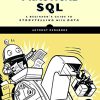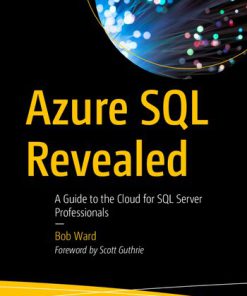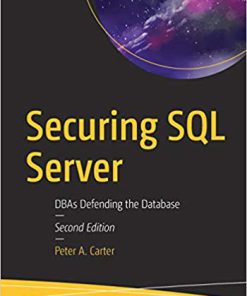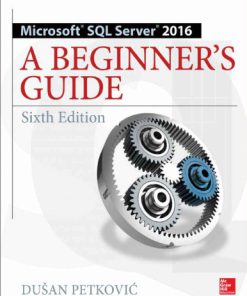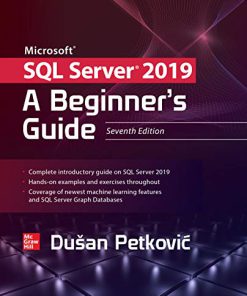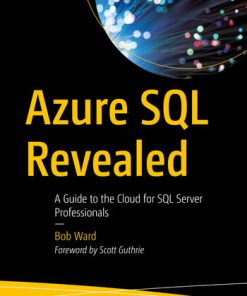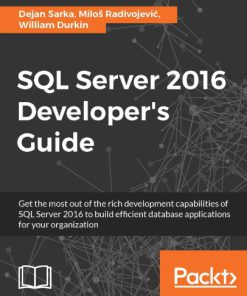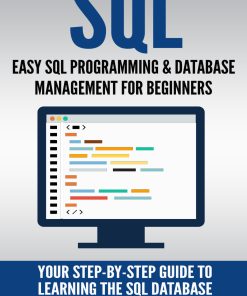SQL Server 2017 Developer’s Guide 1st Edition by Dejan Sarka,William Durkin,Milos Radivojevic 9781786465344 1786465345
$50.00 Original price was: $50.00.$25.00Current price is: $25.00.
SQL Server 2017 Developer Guide 1st Edition by Dejan Sarka,William Durkin,Milos Radivojevic – Ebook PDF Instant Download/Delivery:9781786465344,1786465345
Full download SQL Server 2017 Developer Guide 1st Edition after payment
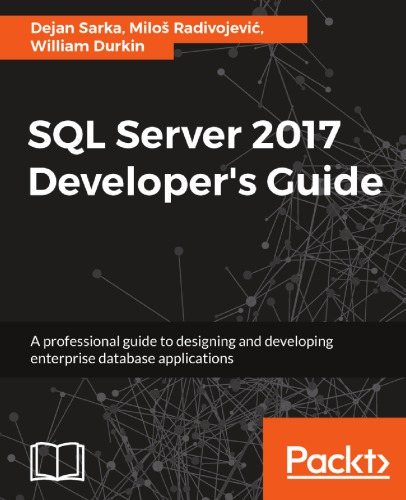
Product details:
ISBN 10:1786465345
ISBN 13:9781786465344
Author:Dejan Sarka,William Durkin,Milos Radivojevic
About This Book
- Utilize the new enhancements in Transact-SQL and security features in SQL Server 2016 to build efficient database applications
- Work with temporal tables to get information about data stored in the table at any point in time
- A detailed guide to SQL Server 2016, introducing you to multiple new features and enhancements to improve your overall development experience
Who This Book Is For
This book is for database developers and solution architects who plan to use the new SQL Server 2016 features for developing efficient database applications. It is also ideal for experienced SQL Server developers who want to switch to SQL Server 2016 for its rich development capabilities. Some understanding of the basic database concepts and Transact-SQL language is assumed.
What You Will Learn
- Explore the new development features introduced in SQL Server 2016
- Identify opportunities for In-Memory OLTP technology, significantly enhanced in SQL Server 2016
- Use columnstore indexes to get significant storage and performance improvements
- Extend database design solutions using temporal tables
- Exchange JSON data between applications and SQL Server in a more efficient way
- Migrate historical data transparently and securely to Microsoft Azure by using Stretch Database
- Use the new security features to encrypt or to have more granular control over access to rows in a table
- Simplify performance troubleshooting with Query Store
- Discover the potential of R’s integration with SQL Server
In Detail
Microsoft SQL Server 2016 is considered the biggest leap in the data platform history of the Microsoft, in the ongoing era of Big Data and data science. Compared to its predecessors, SQL Server 2016 offers developers a unique opportunity to leverage the advanced features and build applications that are robust, scalable, and easy to administer.
This book introduces you to new features of SQL Server 2016 which will open a completely new set of possibilities for you as a developer. It prepares you for the more advanced topics by starting with a quick introduction to SQL Server 2016’s new features and a recapitulation of the possibilities you may have already explored with previous versions of SQL Server. The next part introduces you to small delights in the Transact-SQL language and then switches to a completely new technology inside SQL Server – JSON support. We also take a look at the Stretch database, security enhancements, and temporal tables.
The last chapters concentrate on implementing advanced topics, including Query Store, columnstore indexes, and In-Memory OLTP. You will finally be introduced to R and how to use the R language with Transact-SQL for data exploration and analysis.
By the end of this book, you will have the required information to design efficient, high-performance database applications without any hassle.
Style and approach
This book is a detailed guide to mastering the development features offered by SQL Server 2016, with a unique learn-as-you-do approach. All the concepts are explained in a very easy-to-understand manner and are supplemented with examples to ensure that you—the developer—are able to take that next step in building more powerful, robust applications for your organization with ease.
SQL Server 2017 Developer Guide 1st Table of contents:
1. Introduction to SQL Server 2016
Security
Row Level Security
Dynamic Data Masking
Always Encrypted
Engine features
Query Store
Live Query Statistics
Stretch Database
Database scoped configuration
Temporal Tables
Columnstore indexes
Programming
Transact SQL enhancements
JSON
In-Memory OLTP
SQL Server tools
Business intelligence
R in SQL Server
Release cycles
Summary
2. Review of SQL Server Features for Developers
The mighty Transact-SQL SELECT
Core Transact-SQL SELECT statement elements
Advanced SELECT techniques
DDL, DML, and programmable objects
Data definition language statements
Data modification language statements
Using triggers
Data abstraction – views, functions, and stored procedures
Transactions and error handling
Error handling
Using transactions
Beyond relational
Defining locations and shapes with Spatial Data
CLR integration
XML support in SQL Server
Summary
3. SQL Server Tools
Installing and updating SQL Server tools
New SSMS features and enhancements
Autosave open tabs
Searchable options
Enhanced scroll bar
Execution plan comparison
Live Query Statistics
SQL Server Data Tools
Tools for developing R code
RStudio IDE
R Tools for Visual Studio
Summary
4. Transact-SQL Enhancements
New and enhanced functions and expressions
STRING_SPLIT
STRING_ESCAPE
COMPRESS
DECOMPRESS
CURRENT_TRANSACTION_ID
SESSION_CONTEXT
DATEDIFF_BIG
AT TIME ZONE
HASHBYTES
JSON functions
Enhanced DML and DDL statements
The conditional DROP statement (DROP IF EXISTS)
CREATE OR ALTER
Online Alter Column
TRUNCATE TABLE
Maximum key size for nonclustered indexes
New query hints
NO_PERFORMANCE_SPOOL
MAX_GRANT_PERCENT
MIN_GRANT_PERCENT
Summary
5. JSON Support in SQL Server
Why JSON?
What is JSON?
Why is it popular?
JSON versus XML
JSON objects
JSON object
JSON array
Primitive JSON data types
JSON in SQL Server prior to SQL Server 2016
JSON4SQL
JSON.SQL
Transact-SQL-based solution
Retrieving SQL Server data in the JSON format
FOR JSON AUTO
FOR JSON PATH
FOR JSON additional options
Adding a root node to the JSON output
Including null values in the JSON output
Formatting a JSON output as a single object
Converting data types
Escaping characters
Converting JSON data in a tabular format
OPENJSON with the default schema
Processing data from a comma-separated list of values
Returning the difference between two table rows
OPENJSON with an explicit schema
Import the JSON data from a file
JSON storage in SQL Server 2016
Validating JSON data
Extracting values from a JSON text
JSON_VALUE
JSON_QUERY
Modifying JSON data
Adding a new JSON property
Updating the value for a JSON property
Removing a JSON property
Multiple changes
Performance considerations
Indexes on computed columns
Full-text indexes
Summary
6. Stretch Database
Stretch Database architecture
Is this for you?
Using Data Migration Assistant
Limitations of using Stretch Database
Limitations that prevent you from enabling the Stretch DB feature for a table
Table limitations
Column limitations
Limitations for Stretch-enabled tables
Use cases for Stretch Database
Archiving of historical data
Archiving of logging tables
Testing Azure SQL database
Enabling Stretch Database
Enabling Stretch Database at the database level
Enabling Stretch Database by using wizard
Enabling Stretch Database by using Transact-SQL
Enabling Stretch Database for a table
Enabling Stretch DB for a table by using wizard
Enabling Stretch Database for a table by using Transact-SQL
Filter predicate with sliding window
Querying Stretch Databases
Querying and updating remote data
SQL Server Stretch Database pricing
Stretch DB management and troubleshooting
Monitoring Stretch Database
Pause and resume data migration
Disable Stretch Database
Disable Stretch Database for tables by using SSMS
Disable Stretch Database for tables using Transact-SQL
Disable Stretch Database for a database
Backup and restore Stretch-enabled databases
Summary
7. Temporal Tables
What is temporal data?
Types of temporal table
Allen’s interval algebra
Temporal constraints
Temporal data in SQL Server before 2016
Optimizing temporal queries
Temporal features in SQL:2011
System-versioned tables in SQL Server 2016
How temporal tables work in SQL Server 2016
Creating temporal tables
Period columns as hidden attributes
Converting non-temporal to temporal tables
Migration existing temporal solution to system-versioned tables
Altering temporal tables
Dropping temporal tables
Data manipulation in temporal tables
Querying temporal data in SQL Server 2016
Retrieving temporal data at a specific point in time
Retrieving temporal data from a specific period
Retrieving all temporal data
Performance and storage considerations with temporal tables
History data retention
History table physical implementation
History table overhead
Temporal tables with memory-optimized tables
What is missing in SQL Server 2016?
SQL Server 2016 temporal tables and data warehouses
Summary
8. Tightening the Security
SQL Server security basics
Defining principals and securables
Managing schemas
Object and statement permissions
Encrypting the data
Leveraging SQL Server data encryption options
Always Encrypted
Row-Level security
Using programmable objects to maintain security
Predicate-based Row-Level Security
Exploring dynamic data masking
Defining masked columns
Dynamic data masking limitations
Summary
9. Query Store
Why Query Store?
What is Query Store?
Query Store architecture
Enabling and configuring Query Store
Enabling Query Store with SSMS
Enabling Query Store with Transact-SQL
Configuring Query Store
Query Store default configuration
Query Store Recommended Configuration
Disabling and cleaning Query Store
Query Store in action
Capturing Query info
Capturing plan info
Collecting runtime statistics
Query Store and migration
Query Store – identifying regressed queries
Query Store – fixing regressed queries
Query Store reports in SQL Server management studio
Regressed queries
Top resource consuming queries tab
Overall resource consumption
Query Store use cases
SQL Server version upgrades and patching
Application and service releases, patching, failovers, and cumulative updates
Identifying ad hoc queries
Identifying unfinished queries
Summary
10. Columnstore Indexes
Analytical queries in SQL Server
Joins and indexes
Benefits of clustered indexes
Leveraging table partitioning
Nonclustered indexes in analytical scenarios
Using indexed views
Data compression and query techniques
Writing efficient queries
Columnar storage and batch processing
Columnar storage and compression
Recreating rows from columnar storage
Columnar storage creation process
Development of columnar storage in SQL Server
Batch processing
Nonclustered columnstore indexes
Compression and query performance
Testing the nonclustered columnstore Index
Operational analytics
Clustered columnstore indexes
Compression and query performance
Testing the clustered columnstore Index
Using archive compression
Adding B-Tree indexes and constraints
Updating a clustered columnstore index
Deleting from a clustered columnstore index
Summary
11. Introducing SQL Server In-Memory OLTP
In-Memory OLTP architecture
Row and index storage
Row structure
Row header
Row payload
Index structure
Non-clustered Index
Hash indexes
Creating memory-optimized tables and indexes
Laying the foundation
Creating a table
Querying and data manipulation
Performance comparisons
Natively compiled stored procedures
Looking behind the curtain of concurrency
Data durability concerns
Database startup and recovery
Management of in-memory objects
Dynamic management objects
Extended Events
Perfmon counters
Assistance in migrating to In-memory OLTP
Summary
12. In-Memory OLTP Improvements in SQL Server 2016
Ch-Ch-Changes
Feature improvements
Collations
Data types and types of data
What’s new with indexes?
Unconstrained integrity
Not all operators are created equal
Size is everything!
Improvements in the In-Memory OLTP Engine
Down the index rabbit-hole
Large object support
Storage differences of on-row and off-row data
Cross-feature support
Security
Programmability
High availability
Tools and wizards
Summary
13. Supporting R in SQL Server
Introducing R
Starting with R
R language Basics
Manipulating data
Introducing data structures in R
Getting sorted with data management
Understanding the data
Basic visualizations
Introductory statistics
SQL Server R services
Discovering SQL Server R services
Creating scalable solutions
Deploying R models
Summary
14. Data Exploration and Predictive Modeling with R in SQL Server
Intermediate statistics – associations
Exploring discrete variables
Finding associations between continuous variables
Continuous and discrete variables
Getting deeper into linear regression
Advanced analysis – undirected methods
Principal components and exploratory factor analysis
Finding groups with clustering
Advanced analysis – directed methods
Predicting with logistic regression
Classifying and predicting with decision trees
Advanced graphing
Introducing ggplot2
Advanced graphs with ggplot2
People also search for SQL Server 2017 Developer Guide 1st:
microsoft sql server 2017 developer edition
download sql server 2017 developer edition for windows
2017 sql server management studio
visual studio 2017 developer edition
sql server 2017 developer
Tags:
Dejan Sarka,William Durkin,Milos Radivojevic,Server,Developer,SQL
You may also like…
Computers - Programming
Azure SQL Revealed: A Guide to the Cloud for SQL Server Professionals Bob Ward
Computers - Computer Science
Computers - Databases
Securing SQL Server DBAs Defending the Database 2nd Edition by Peter Carter 1484241615 9781484241615
Computers - Databases
Computers - Programming
Microsoft SQL Server 2016 a beginners guide 6th Edition by Dusan Petkovic 1259641791 9781259641794
Computers - Programming
Microsoft SQL Server 2019: A Beginner’s Guide Dusan Petkovic
Computers - Programming
Computers - Databases



